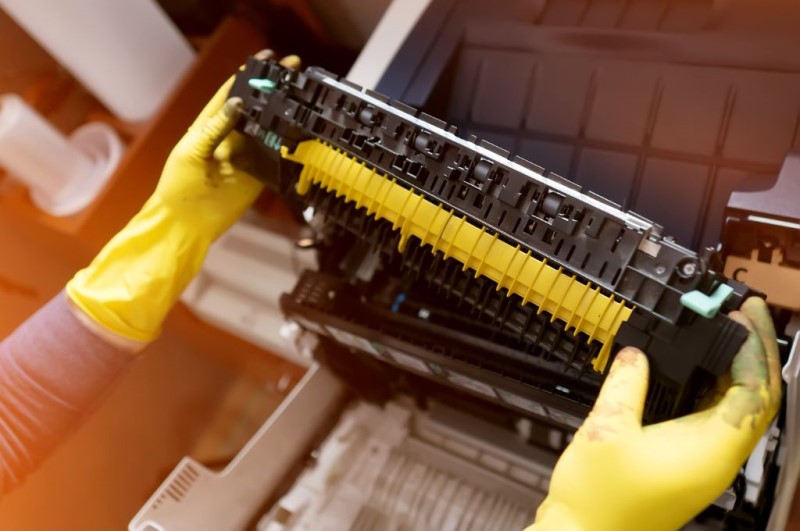
Simply put, a fuser is the unit which is responsible for fixing toner into the paper. It has two primary rollers which apply heat and pressure as the paper passes in between them. Unfused images I’ve handled merely wipe off the paper.
The temperature inside a fuser unit ranges between 180° to 210° Celsius (356°-410° F). The pressure inside a fuser is between 4 to 9 kilograms. (10 to 20 lbs). Other rollers inside a fuser function to clean, apply fuser oil, or in some cases heat.
The fuser roller, commonly called upper fuser roller, is a hard roller with either a Teflon or silicon coating. A heating element is located inside this roller. In faster printers, I’ve seen heating elements inside two other rollers in contact with the fuser roller.
The pressure roller, commonly called lower fuser roller, is a semi soft material. It has a silicon coating. The pressure applied from this roller is adjusted to correct the fuser nip. Fuser nip is the width of the bite, or flat spot where the rollers contact, typically between 5 to 7 millimeters
Common Problems
Fusers are common causes of error codes in my experience. A thermistor tells the printer the temperature of the fuser. If it’s too cold or too hot the printer displays an error code. Common points of failure are a burnt out heating element, blown thermal fuse, triggered thermal switch, or a bad thermistor itself.
Heating elements inside a fuser are induction, heat lamps, or resistors. These components eventually fail after so many heating and cooling cycles.
In my experience print quality issues are another common problem caused by a fuser. The non-stick coating on fuser rollers eventually wears off after 100,000 pages or more. Once that happens toner starts sticking.
Ghosting is where a faint image is lifted from the top of a page and placed at the bottom of the page. This can also happen from one page to another. Tracking is where spots or smears of toner build up on the upper fuser roller. Which then track spots on some or all pages going through the fuser.
I’ve used WD-40 and a rag to clean built up toner from fuser rollers. It gets rid of the ghosting and tracking issues. However, once the coating on a fuser roller is weak cleaning it is only temporary. I only clean them to keep the printer running long enough to get a new fuser.
Fusers are also a common source of noises in my experience. The heat dries out the grease inside the bearings. Which causes squeaking or squealing noises.
Drive gears require a lot of torque due to the pressure between the rollers. They are prone to breaking. Gears also slip causing a grinding noise.
FAQ
Fuser rollers apply heat and pressure to permanently melt toner into paper.
The fuser is the unit in a printer that fixes toner onto paper.
Tracking and ghosting are commonly caused by bad fusers. As the coating on the rollers wears on their non stick surface, toner begins to stick. Tracking is a spot or smear of toner buildup that is left on pages as they pass through. Ghosting is where a light image of the previous image is picked up and placed on the next page to pass through.
Toner is the pigment. It’s the dry powder which forms the image on the paper. A fuser is a part inside a printer. It applies heat and pressure to melt toner

The Copier Guy, aka Dave. I’ve worked on scanners, printers, copiers, and faxes since 1994. When I’m not fixing them I’m writing about them. Although, I’m probably better at fixing them. I’ve worked with every major brand. As well as several types of processes. If it uses paper I’ve probably worked on one.





